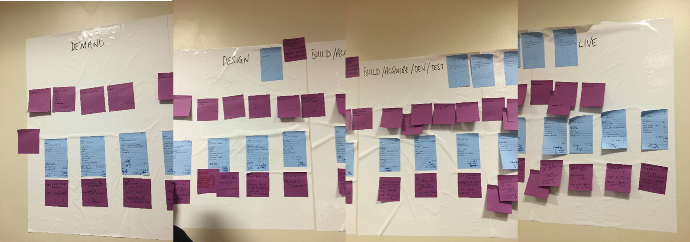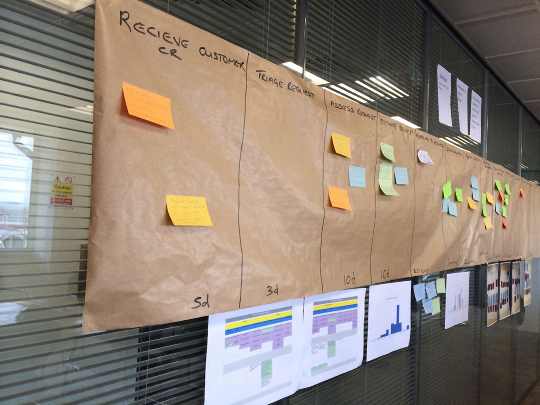
Case Study: Using Value Stream Mapping for IT Service Improvement
This was the situation: my customer had a dysfunctional business. It wasn’t a large company, and many employees had been there for years; and discussions were led, and decisions were made, by committees and reports. Life wasn’t good, and the competition was nibbling away at opportunities that the company should have won.
More importantly, there was a regulatory requirement the company needed to meet, requiring a new process across all of its customers, for which no action had commenced. The CFO wanted a way to get a conversation going, that would wake up her CIO and his teams and make the required change happen.
The lack of movement wasn’t for a want of trying – Agile, Lean, DevOps, all sorts of things had been tried but with little sustainable success. It had more to do with how disparate leaders and teams worked, or didn’t work, together.
My Bet That People Could Work Together on a Shared Goal
I asked the CFO for four days of time, over a two-week period, to conduct a paid-for workshop that would get things done, although having all four days together would be preferred.
I bet her that if she got her 8-12 managers, from all the involved areas and who had accountability for bringing this critical process to life, together in a room where we would discuss why the process needed to occur, how it needed to look, and what needed to happen to get things done in a way where they all knew what was happening – then they (or we) would get the regulatory requirement met!
The wager was £100 to my favorite charity if I/we succeeded, and the workshop was free if I lost. She accepted my wager somewhat greedily.

Leveraging Value Stream Mapping (to Win My Bet)
In my opinion, this challenge required value stream mapping, where:
“A value stream is all of the actions (both value creating and non-value creating) currently required to bring a product through the main flows essential to every product” ~ Lean.org
The mapping of that stream begins with asking WHY we want the stream, HOW we think it looks today, and WHAT it should look like tomorrow.
However, the first two questions posed by the CFO, when starting the workshop, were:
- Do you all know each other?
- Have you ever discussed together – from the customer services to delivery service teams – how something should work?
These were all director-level people charged with managing the lifecycle of a customer and the regulatory requirements across the entire company. So, she was flabbergasted when most agreed that they knew each other’s names from emails and reports but they had never worked together as a team, even though they were all accountable for this major process among others.
Kerching to my favorite charity ![]()
We’d immediately identified a big contributing issue or root cause – the lack of communication and collaboration between functional silos and their people. The bet was as good as won!
The Value Mapping Days
Day 1
On day one the group discussed what “good” looks like and the “why” of this process. By the end of the day, they had signed a charter of intent and agreed associated metrics.
Day 2
On day two they used post-it notes to review:
- How the process worked today
- How long it took
- Where work really incurred in each main step
- The quality achieved along the flow
- The number of people involved
- The number of meetings
- The technology involved

By lunch time there was a lot of discomfort in the room. By the afternoon coffee break there was rebellion and chaos as the “laundry” they were airing was pretty dirty.
By the end of the day they realized, and grudgingly acknowledged, the mess that they, as a team, had allowed to happen. They were also in full agreement that changing the collaboration, communication, and commitment across the value stream (at all levels) would bring fast, sustainable improvement.
Finally, they began to see how this approach could be used in other value streams to help ensure consistent behavior and to introduce a change in company culture and attitude.
Day 3
On day three, without thinking of the “who” or the things needed, they created a “new way.” At first, they just nibbled here and there but then they really made real change as, on the first day, they had agreed a success metric that was pretty aggressive to meet. Day three ended with satisfaction but also apprehension as to whether or not the “new way” could be achieved.
Day 4
On day four they created a set of sprints, with a target for each, over the next 90 days. They would meet every week to review progress and they assigned an owner for the stream, collaborated on how this would be best communicated, and signed on to the new process strategy.
What Was Achieved and How?
The day one charter, the post-it notes of the current and future process, and the transition plan were posted on the walls in significant work areas. They sold the plan to vested parties (from those involved in day-to-day operations to top management), tried things, and rewarded effort as well as success; and had over-achieved by day 90.

The main trick was that they didn’t focus on just one constraint. They kept their eyes on the whole value stream, and every change had to positively answer the question: “Will this make it better, faster, safer?” They promised that no one would lose their job. They didn’t directly focus on cost savings (although it was a positive outcome) and, most importantly, they let their people get involved.
It was so successful they created teams to work on other processes and, since it was already their day job, no one was really inconvenienced by the ongoing improvement activity. It was a testament to the power of value stream mapping.
Have you used value stream mapping to make your company better, faster, and safer? If not, get a strong facilitator. Get executive support. And allow your staff to be involved. You might be surprised by the improvements you deliver.






